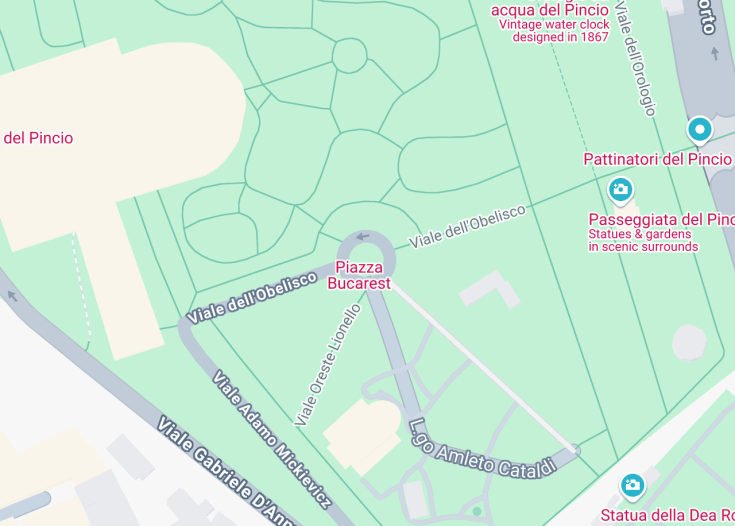The Pinciano Obelisk, a magnificent ancient monument located on the Pincian Hill in Rome, stands as a testament to the enduring legacy of the Roman Empire. Commissioned by Emperor Hadrian in memory of his beloved companion Antinous, this striking structure is rich in history and artistry, drawing visitors from across the globe.
To enhance your visit to the Pinciano Obelisk, consider arriving early in the morning to experience the serene atmosphere before the crowds gather. The surrounding gardens offer stunning views of the city, creating an ideal setting for reflection.
For a memorable experience, pair your visit to the Pinciano Obelisk with a leisurely stroll through the adjacent Villa Borghese park. This stunning landscape not only complements the obelisk’s grandeur but also provides ample opportunities for relaxation and exploration.
Pinciano Obelisk: A Monument to Love and Loss
The Pinciano obelisk, a striking ancient monument located in Rome, Italy, stands as a poignant symbol of emperor Hadrian’s profound grief for his beloved companion, Antinous. Commissioned by Hadrian around the 2nd century AD, this 9.25-meter tall obelisk was originally erected at his villa in Tivoli before being relocated multiple times before finding its current resting place on the scenic Pincian Hill. Visitors are captivated by its history, tracing back to the deification of Antinous after his untimely death by the Nile. The obelisk is adorned with inscriptions that celebrate its restoration and the beauty of its new surroundings. A visit to this monument not only offers a glimpse into the past but also allows tourists to enjoy the stunning vistas of the Eternal City from the Pincian Hill. Its sheer presence serves as a testament to romantic devotion and the enduring legacy of history within Rome.
Activities to Enjoy at the Pinciano Obelisk
When visiting the Pinciano obelisk, tourists can engage in several delightful activities. The surrounding gardens provide the perfect backdrop for leisurely strolls, while photography enthusiasts can capture the obelisk against the breathtaking cityscape.
Relax and Unwind
The lush greenery surrounding the obelisk offers peaceful spots to relax. Visitors can enjoy a picnic while soaking up the sun in this picturesque location.
Cultural Exploration
Additionally, the nearby Pincio terraces offer an exquisite view of Piazza del Popolo, adding to the overall cultural experience. Don’t miss the chance to indulge in local gelato from kiosks nearby as you absorb the beauty of this landmark.
Interesting Fact about the Pinciano Obelisk
One captivating fact about the Pinciano obelisk is its journey through time. Originally erected to commemorate Antinous, it was lost for centuries before being rediscovered near the Porta Maggiore. This obelisk’s long and tumultuous history reflects the resilience of ancient monuments, showcasing their ability to survive the ravages of time and human neglect. Its restoration by Pope Pius VII in the early 19th century brought it back to life, allowing modern visitors to appreciate both its aesthetic beauty and the moving story it represents. This blend of history and artistry makes the Pinciano obelisk a must-see for anyone exploring Rome.
Discover the Majestic Pinciano Obelisk in Rome, Italy
The Pinciano Obelisk is a stunning monument that captures the essence of Rome’s rich history and architectural beauty. Commissioned by Emperor Hadrian in memory of his beloved companion Antinous, who tragically met his end by the Nile, this magnificent structure stands at an impressive height of 9.25 meters (30.4 feet). Visitors can expect to witness not just an exquisite piece of Roman history but also a captivating story behind its creation and relocation over the centuries.
This obelisk is ideal for history buffs, art lovers, and anyone keen to immerse themselves in the deep roots of Roman culture. Located in the beautiful Pincian Hill area, the obelisk offers breathtaking views over the city and is a popular spot for those wishing to explore the Greater Trastevere neighborhood afterward. Combine your visit with a stroll through nearby gardens or cafés, making it a perfect stop on a broader Roman itinerary.
One of the unique aspects of the Pinciano Obelisk is its inscriptions that tell the story of its restoration by Pope Pius VII in 1822, returning it to its former glory after centuries of neglect. As you stand before this giant monument, take a moment to ponder the mysteries surrounding Antinous and Hadrian’s profound bond.
For a truly memorable experience, consider visiting during the early morning or late afternoon. These times offer softer lighting for photography and a chance to enjoy fewer crowds. Make sure to bring your camera to capture the obelisk against the backdrop of the stunning Roman skyline.
Best Time to Visit the Pinciano Obelisk in Rome, Italy
The ideal time to visit the Pinciano Obelisk is during the spring and early fall months when the weather is pleasantly mild. Additionally, weekdays tend to be less crowded than weekends, providing a more serene experience.
Annual Events and Seasonal Highlights
Concrete annual events may not occur at the Pinciano Obelisk itself; however, the nearby gardens often host small local festivals and cultural gatherings during the summer months. These events can be a delightful addition to your visit, allowing you to experience local traditions and celebrations alongside the historical monument.
Accessibility and Limitations
While the Pinciano Obelisk is accessible to most visitors, the surrounding areas may present some limitations due to terrain. Comfortably navigate the paths leading to the obelisk, although they can be steep in certain sections.
Accessibility
Limitations
- Steep paths to reach the obelisk.
- Limited seating available nearby for resting.
- Potentially crowded during peak tourist season.
Notes to Visitors
- Bring water, especially on warm days, as the surrounding area has little shade.
- Consider visiting during off-peak hours to fully enjoy the monument.
- Respect the monument and its surrounding areas by not climbing on the obelisk for photographs.
General Information
Details for your visit to the Pinciano Obelisk
Location
The Pinciano Obelisk is located near the famed Pincian Hill, easily recognizable by its impressive height and intricate inscriptions. It is within walking distance of several notable landmarks, including the Spanish Steps and Villa Borghese, making it conveniently positioned for an enriching day of exploration.
Address:
Villa Borghese, Viale dell'Obelisco, 00197 Roma RM, ItalyVisiting Information
The Pinciano Obelisk is open to the public without strict closing times, allowing visitors the opportunity to marvel at its grandeur at any hour. Early morning and late afternoon are particularly recommended for a more peaceful experience while enjoying the picturesque surroundings.
How to Reach the Pinciano Obelisk
Reaching the Pinciano Obelisk is straightforward, with various modes of transport available from the city center:
Car
The Pinciano Obelisk can be easily accessed by car. There are parking options available nearby for a nominal fee.
| Route | Distance | Travel Time |
|---|---|---|
| From Roma Termini Station | 3 miles (4.8 km) | 15 minutes |
| From the Vatican City | 2.5 miles (4 km) | 10 minutes |
| From the Colosseum | 2 miles (3.2 km) | 12 minutes |
Public Transport
Several buses and trams service the area, providing easy access to the monument.
| Route | Frequency | Travel Time |
|---|---|---|
| Bus 119 from Piazza del Popolo | Every 15 minutes | 10 minutes |
| Tram 19 from Trastevere | Every 20 minutes | 15 minutes |
| Bus 87 from Termini Station | Every 10 minutes | 12 minutes |
Nearby Attractions
Explore these nearby gems after visiting the Pinciano Obelisk:
- Villa Borghese – 0.5 miles (0.8 km)
- Spanish Steps – 0.8 miles (1.3 km)
- Pincian Hill Gardens – 0.3 miles (0.5 km)
- Galleria Borghese – 0.6 miles (1 km)
- Bioparco di Roma – 0.9 miles (1.5 km)
- Piazza del Popolo – 0.7 miles (1.1 km)
- Fontana del Tritone – 1 mile (1.6 km)
- Villa Medici – 0.6 miles (1 km)
- Santa Maria del Popolo – 0.8 miles (1.3 km)
- Palazzo di Giustizia – 1.5 miles (2.4 km)
- Castel Sant’Angelo – 1.7 miles (2.7 km)
- Vatican Museums – 2 miles (3.2 km)
Common Questions
What is the history of the Pinciano Obelisk?
The Pinciano Obelisk, originally erected by Emperor Hadrian to commemorate his young companion Antinous, has a fascinating history intertwined with the Roman Empire. It was commissioned in the 2nd century AD after Antinous died under mysterious circumstances while traveling with Hadrian in Egypt. Hadrian not only deified Antinous but also ordered the construction of Antinoöpolis in his honor.
The obelisk initially stood at Hadrian’s villa in Tivoli before being moved to the Circus Varianus in Rome in the 3rd century. After lying underground for centuries, it was excavated near the Porta Maggiore and later transferred to the Vatican by Pope Clement XIV. Finally, in 1822, it was relocated to its current site on Pincian Hill upon the orders of Pope Pius VII, who aimed to restore and embellish this historic monument for the enjoyment of citizens and visitors alike.
What are the inscriptions on the Pinciano Obelisk?
The Pinciano Obelisk features three distinct inscriptions on its pedestal. The two shorter inscriptions commemorate specific dates:
- SACRI / PRINCIPATVS / EIVS /ANNO XXIII: Indicating the 23rd year of the sacred pontificate (of Pope Pius VII).
- XI KAL / SEPTEMB / ANNO MDCCC / XXII: Referring to the 11th day before the Kalends of September in the year 1822.
The main inscription, which is longer and more detailed, reads: PIVS · VII · PONT · MAX · / OBELISCVM · AVRELIANVM / QVI · VNVS · SVPERERAT / TEMPORVM · INIVRIA / DIFFRACTVM / DIVQVE · OBLITVM / IN · PRISTINAM · FACIEM · RESTITVI / ATQVE · HOC · IN · LOCO · ERIGI · IVSSIT / VT · AMOENA · PINCII · SPATIA / CIVIBUS · AD · APRICANDVM · APERTA / EXIMII · GENERIS · MONVMENTO / DECORARET.
This translates to: “Pius VII, Pontifex Maximus, ordered the Aurelian obelisk, which survived the ravages of Time, broken in pieces and long forgotten, to be erected in the Pincio and returned to its ancient form, so that it could decorate the sunny spaces, so much appreciated by the citizens.” This inscription highlights the obelisk’s restoration and its significance in beautifying the Pincian Hill area.
What is the architectural style of the Pinciano Obelisk?
The Pinciano Obelisk showcases the distinctive architectural style of ancient Egyptian obelisks, characterized by their tall, narrow, four-sided shape that tapers to a pyramidal point at the top. These granite structures were traditionally erected in pairs at the entrances of temples in ancient Egypt and were viewed as monumental symbols of the sun god Ra.
This specific obelisk, like many Roman obelisks, underwent modifications during its relocation and restoration process, but retains the essential elements that define the genre. Its smooth, polished surface likely exhibited intricate hieroglyphs in its original context, representing the deeds and accomplishments of the Pharaohs or explaining religious beliefs.
The addition of a contemporary pedestal by Pope Pius VII in the early 19th century further enhances the monument’s appearance while reflecting the neoclassical style prevalent during that period. Together, the ancient Egyptian and neoclassical influences create a unique blend that underscores the Pinciano Obelisk’s historical significance and aesthetic appeal.
Why is Antinous significant to Roman history?
Antinous, a youth from Bithynia, is significant to Roman history primarily for his close association with Emperor Hadrian, which symbolized the deep emotional bond between a ruler and his favored companion. Born in the early 2nd century, Antinous was introduced to Hadrian during the emperor’s travels and quickly became his confidant and companion during his extensive journeys around the empire. This unique relationship has made him a figure of poignant interest in historical narratives.
Antinous’s mysterious death in 130 AD while visiting Egypt prompted Hadrian to take extraordinary measures to honor him. He initiated the deification of Antinous, similar to how emperors were often idolized posthumously, and commissioned statues and monuments in his name across the empire. Hadrian also established Antinoöpolis, dedicating a city to his memory, a rare honor reflecting Antinous’s importance in Hadrian’s life.
The aesthetic beauty of surviving artwork depicting Antinous, along with his connections to Hadrian, allow historians and art enthusiasts to explore themes of love, loss, and deification in the Roman world, making Antinous a compelling figure whose legacy resonates well beyond the ancient past.
How did the Pinciano Obelisk reflect Hadrian's relationship with Antinous?
The Pinciano Obelisk stands as a monumental testament to the profound relationship between Emperor Hadrian and Antinous. After the untimely death of Antinous in 130 AD, Hadrian’s sense of loss was so immense that he chose to immortalize his companion through both deification and massive architectural memorials. The obelisk served not only as a physical tribute but also as a public symbol of Hadrian’s affection and commitment to preserving Antinous’s memory.
Hadrian’s decision to commission the obelisk to mark Antinous’s death, along with the founding of the city Antinoöpolis in his honor, illustrates the lengths to which he would go to honor their bond. The obelisk’s original placement at Hadrian’s villa and its subsequent journey to the Circus Varianus before finally residing on Pincian Hill mirrors the enduring nature of their connection, as it was culturally significant in both his personal life and imperial ambitions.
Additionally, the numerous statues depicting Antinous throughout the Roman Empire serve to further emphasize Hadrian’s dedicated quest to ensure his beloved companion would never be forgotten, thus making the obelisk an emblematic structure reflecting their unique and complex relationship.

Is the Pinciano Obelisk in Rome worth visiting?
The Pinciano Obelisk is certainly worth a visit for tourists interested in history and art. This ancient structure, originally commissioned by Emperor Hadrian to honor his beloved companion Antinous, provides insight into the Roman Empire’s rich cultural legacy. Standing at 9.25 meters tall, the obelisk is not only a stunning architectural feat but also a captivating story of loss, memory, and deification. Its journey from Tivoli to its current location offers a glimpse into the preservation efforts undertaken by various popes, notably Pius VII, who restored the monument. Visitors can appreciate the intricate inscriptions that recount its history and significance, making it an enriching experience for anyone exploring Rome.









